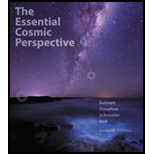
The Essential Cosmic Perspective (7th Edition) - Standalone book
7th Edition
ISBN: 9780321928085
Author: Jeffrey O Bennett, Megan O. Donahue, Nicholas Schneider, Mark Voit
Publisher: PEARSON
expand_more
expand_more
format_list_bulleted
Concept explainers
Question
Chapter 8, Problem 41EAP
To determine
whether the moons of Jupiter can be identified and recognized when observed over a period of time? Whether the orbital periods of these moons can be measured? Can their approximate distance from Jupiter be measured?
Expert Solution & Answer
Want to see the full answer?
Check out a sample textbook solution
Students have asked these similar questions
3
Set
ба
||Axl
49.32
6b
71
Ay
22
Magnitude of A
Angle of A
24.04
Angle of -A
22
54
155.96
° (pos Ax) 204.04
° (neg Ax) 335.96
°
(pos Ax)
° (neg Ax)
115.77
° (pos Ax) 295.77
° (pos Ax)
-39
81
208.78
° (neg Ax) 28.78
°
(neg Ax)
3AA . not sure what i am getting wrong
Chapter 8 Solutions
The Essential Cosmic Perspective (7th Edition) - Standalone book
Ch. 8 - Prob. 1VSCCh. 8 - Prob. 2VSCCh. 8 - Prob. 3VSCCh. 8 - Prob. 4VSCCh. 8 - Prob. 1EAPCh. 8 - Prob. 2EAPCh. 8 - Prob. 3EAPCh. 8 - Prob. 4EAPCh. 8 - Prob. 5EAPCh. 8 - Prob. 6EAP
Ch. 8 - Prob. 7EAPCh. 8 - Describe key features of Jupiter's four Galilean...Ch. 8 - Prob. 9EAPCh. 8 - Why do we think Triton is a captu red moon? How...Ch. 8 - Briefly explain why icy moons can have active...Ch. 8 - What ar e planetary rings made of, and how do they...Ch. 8 - Prob. 13EAPCh. 8 - Saturn’s core is pockmarked with impact craters...Ch. 8 - Neptune's deep bllle color is not due to methane,...Ch. 8 - A jovian planet in another star system has a moon...Ch. 8 - A planet orbiting another star is made primarily...Ch. 8 - A previously unknown moon orbits Jupiter outside...Ch. 8 - Prob. 19EAPCh. 8 - An icy, medium-size moon orbits a jovian planet in...Ch. 8 - A jovian planet is discovered in a star system...Ch. 8 - Future observations discover rainfall of liquid...Ch. 8 - During a future mission to Uranus, scient ists...Ch. 8 - Which lists the jovian planets in order of...Ch. 8 - Why does Neptune appear blue and Jupiter red? (a)...Ch. 8 - Prob. 26EAPCh. 8 - Prob. 27EAPCh. 8 - 28. The main ingredients of most moons of the...Ch. 8 - Prob. 29EAPCh. 8 - Prob. 30EAPCh. 8 - Whid1 moon shows evidence of rainfall and erosion...Ch. 8 - Prob. 32EAPCh. 8 - Prob. 33EAPCh. 8 - 34. Europan Ocean. Scientists strong ly suspect...Ch. 8 - Breaking the Rules. As discussed in Chapter 7, the...Ch. 8 - Unanswered Question. Choose one unans wered...Ch. 8 - Comparing Jovian Moons. Roles: Scribe (collect s...Ch. 8 - The Importance of Rotation. Suppose the material...Ch. 8 - Comparing Jovian Planets. You can do comparative...Ch. 8 - Prob. 40EAPCh. 8 - Prob. 41EAPCh. 8 - Prob. 42EAPCh. 8 - Disappearing Moon. lo loses about a ton (1000...Ch. 8 - 44. Ring Particle Collisions. Each ring particle...Ch. 8 - Prometheus and Pandora. These two moons orbit...Ch. 8 - Prob. 46EAPCh. 8 - Titanic Titan. What is the ratio of Titan's mass...Ch. 8 - Saturn’s Thin Rings. Saturn's riing system is over...Ch. 8 - Jovian Planet Mission. We can study terrestrial...Ch. 8 - Prob. 50EAPCh. 8 - Prob. 51EAPCh. 8 - Prob. 52EAP
Knowledge Booster
Learn more about
Need a deep-dive on the concept behind this application? Look no further. Learn more about this topic, physics and related others by exploring similar questions and additional content below.Similar questions
arrow_back_ios
SEE MORE QUESTIONS
arrow_forward_ios
Recommended textbooks for you
 College PhysicsPhysicsISBN:9781305952300Author:Raymond A. Serway, Chris VuillePublisher:Cengage Learning
College PhysicsPhysicsISBN:9781305952300Author:Raymond A. Serway, Chris VuillePublisher:Cengage Learning University Physics (14th Edition)PhysicsISBN:9780133969290Author:Hugh D. Young, Roger A. FreedmanPublisher:PEARSON
University Physics (14th Edition)PhysicsISBN:9780133969290Author:Hugh D. Young, Roger A. FreedmanPublisher:PEARSON Introduction To Quantum MechanicsPhysicsISBN:9781107189638Author:Griffiths, David J., Schroeter, Darrell F.Publisher:Cambridge University Press
Introduction To Quantum MechanicsPhysicsISBN:9781107189638Author:Griffiths, David J., Schroeter, Darrell F.Publisher:Cambridge University Press Physics for Scientists and EngineersPhysicsISBN:9781337553278Author:Raymond A. Serway, John W. JewettPublisher:Cengage Learning
Physics for Scientists and EngineersPhysicsISBN:9781337553278Author:Raymond A. Serway, John W. JewettPublisher:Cengage Learning Lecture- Tutorials for Introductory AstronomyPhysicsISBN:9780321820464Author:Edward E. Prather, Tim P. Slater, Jeff P. Adams, Gina BrissendenPublisher:Addison-Wesley
Lecture- Tutorials for Introductory AstronomyPhysicsISBN:9780321820464Author:Edward E. Prather, Tim P. Slater, Jeff P. Adams, Gina BrissendenPublisher:Addison-Wesley College Physics: A Strategic Approach (4th Editio...PhysicsISBN:9780134609034Author:Randall D. Knight (Professor Emeritus), Brian Jones, Stuart FieldPublisher:PEARSON
College Physics: A Strategic Approach (4th Editio...PhysicsISBN:9780134609034Author:Randall D. Knight (Professor Emeritus), Brian Jones, Stuart FieldPublisher:PEARSON

College Physics
Physics
ISBN:9781305952300
Author:Raymond A. Serway, Chris Vuille
Publisher:Cengage Learning

University Physics (14th Edition)
Physics
ISBN:9780133969290
Author:Hugh D. Young, Roger A. Freedman
Publisher:PEARSON

Introduction To Quantum Mechanics
Physics
ISBN:9781107189638
Author:Griffiths, David J., Schroeter, Darrell F.
Publisher:Cambridge University Press

Physics for Scientists and Engineers
Physics
ISBN:9781337553278
Author:Raymond A. Serway, John W. Jewett
Publisher:Cengage Learning

Lecture- Tutorials for Introductory Astronomy
Physics
ISBN:9780321820464
Author:Edward E. Prather, Tim P. Slater, Jeff P. Adams, Gina Brissenden
Publisher:Addison-Wesley

College Physics: A Strategic Approach (4th Editio...
Physics
ISBN:9780134609034
Author:Randall D. Knight (Professor Emeritus), Brian Jones, Stuart Field
Publisher:PEARSON
General Relativity: The Curvature of Spacetime; Author: Professor Dave Explains;https://www.youtube.com/watch?v=R7V3koyL7Mc;License: Standard YouTube License, CC-BY